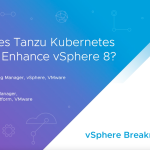by Don Sullivan, Product Line Marketing Manager, Business Critical Applications – vSphere
There has been a dramatic increase of virtualized infrastructure being used for production-level business critical applications (BCAs) including relational database management systems (RDBMS) such as Oracle and SQL Server. With the release, of vSphere 4.x in 2009, Tier 1 implementations on vSphere became a reality.
With the recent releases of vSphere 5.x and the abstract approach of the Software-Defined Data Center (SDDC) the proposition of running BCAs and RDBMS such as SQL Server is truly compelling. The comprehensive overhead imposed by the hypervisor had dropped precipitously and vertical scalability up to 64 vCPUs and 1TB of RAM was now real. As systems and database administrators (DBAs) examined their options for expensive hardware refreshes, they started to seriously consider virtualization as a viable alternative to rip and replace hardware upgrades. At this point, VMware began a steadfast venture to foster awareness among its customer base towards the suitability of vSphere as the platform for all applications including database implementations.
ESXi is a type 1, non-paravirtualized hypervisor, which means that it runs on the bare-metal machine and it makes no kernel alterations to the Guest Operating System (GOS). vSphere is a platform of virtualized hardware which translated means that vSphere should be understood, managed and discussed as logical hardware. Each virtual machine (VM) created is a separate server that is now, due to the magic of vSphere, logically disconnected from the hardware.
The value of vSphere in regards to BCAs must be deferred until the DBAs are convinced that the platform has the innate ability to run high workload applications. To answer this question we should first separate performance into 4 separate dimensions: processing, memory, network and storage. If the architect and administrators follow VMware best practices and properly allocate the required resources to the VM, an exercise called “Right-Sizing”, the overall performance degradation caused by the virtualization layer should be less than 10%. VMware has detailed best practice guides for the popular RDBMS such as Oracle and SQL Server as well as the popular enterprise level applications. In addition, there are a number of recently or soon to be published books on these subjects:
- http://www.vmware.com/files/pdf/solutions/SQL_Server_on_VMware-Best_Practices_Guide.pdf
- http://www.vmware.com/files/pdf/partners/oracle/Oracle_Databases_on_VMware_-_Best_Practices_Guide.pdf
- http://www.vmware.com/files/pdf/techpaper/vmw-understanding-oracle-certification-supportlicensing-environments.pdf
- http://www.amazon.com/Virtualizing-SQL-Server-VMware-Technology/dp/0321927753
- http://www.amazon.com/Virtualizing-Oracle-Databases-vSphere-Technology/dp/0133570185
The value of vSphere for BCA and respectively SQL Server comes in two separate categories, resource management capabilities and the set of features that allow the application owners and administrators to meet their Service Level Agreements (SLAs). In addition to performance, security, and provisioning requirement, all BCA have requirements for uptime in the event of a server failure and recovery time when facing a disaster. The broad and powerful set of features which are intrinsic capabilities of vSphere address all of those concerns. The administrators can use vSphere HA, which can be configured in minutes for the entire ESXi cluster to circumvent significant downtime due to server failures. Downtime for hardware maintenance should be eliminated with the use of vMotion and “Maintenance” mode. Distributed Resource Scheduler (DRS) will use vMotion to automatically move VMs within the ESXi/DRS cluster to distribute load. Hot add can be used to dynamically add resources to a VM to respond to usage bursts. Site Recovery Manager (SRM) is a workflow orchestration system which facilitates the coordination of the VMs and the storage failovers when disaster strikes. Network administrators can use a virtual distributed switch (vDS) to simplify their network architectures. And most importantly the SDDC extends the most profound notions of virtualization to the network and storage layers so that the entire stack is truly virtualized. This means that all the applications, critical or casual, should be considered candidates for inclusion in a true SDDC.
The SQL Server database administrator should quickly understand that the capabilities of vSphere and the SDDC enhances the value of the systems that they manage and subsequently increases the value of the application running on those databases. The SDDC therefore makes the DBA and other administrators more effective at managing their systems and more valuable to their companies. This is the age of the vDBA where the DBA embraces the proposition of virtualized infrastructure and the modern information systems architectures of the 21st century.
This week, VMware in partnership with Pure Storage has invited world-renowned SQL Server experts, many of who are also SQL MVPs, to their respective headquarters in Palo Alto to take part in an elite SQL Server on vSphere workshop. For three days, the 15 experts will meet with executives and participate in discussions with distinguished VMware and Pure Storage engineers. This group will also work on Hands-on-Labs that have been customized specifically for this group, which includes SQL Server on vSphere and Pure Storage exercises. Collaborative events throughout the week will allow these experts to get to know each other as well as the VMware and Pure Storage product teams who are committed to SQL Server running on vSphere.
The experts participating in this elite workshop include:
- Mike Corey – President Ntirety Corp and author of 18 books
- David Klee – Founder of Heraflux
- Kevin Kline – Director of Engineering Services SQL Sentry Corp
- Grant Fritchey – Red Gate Software and author of three SQL Server books
- Argenis Fernandez – Sqlblog.com
- Thomas LaRock – President SQL Pass
- Christopher Bell – DC chapter of PASS founder – 30+ events this year – CEO WaterOX Consulting
- Rodney Landrum – SQL Saturdays regular and many well-known blogs
- Kendal Van Dyke – Upsearch Principle Consultant
- Keith Allen Kinsel – SQL Saturday Advisory Council
- Joseph D’Antoni – Senior Architect Anexinet
- Denny Cherry – Denny Cherry Associates and Consulting Founder
- Andrew J. Kelly – SoildQ Corp – Weekly speaker at events worldwide
- Allen White – Upsearch Corp – Ohio SQL User group president – writes for SQL Pass Magazine
- Andy Galbraith – Ntirety Corp
Follow us on Twitter (@VMwarevSphere) and Facebook (VMwarevSphere) for updates on this inaugural SQL Server on vSphere workshop.















